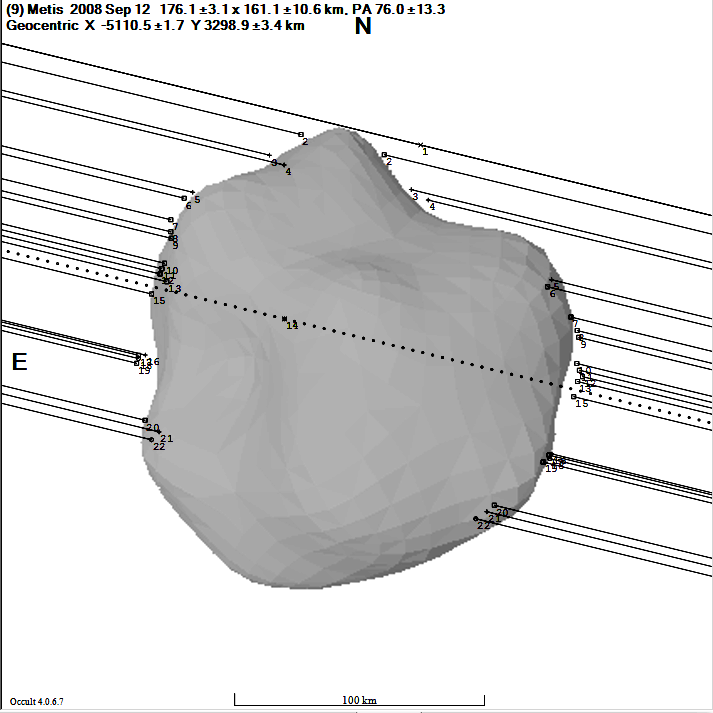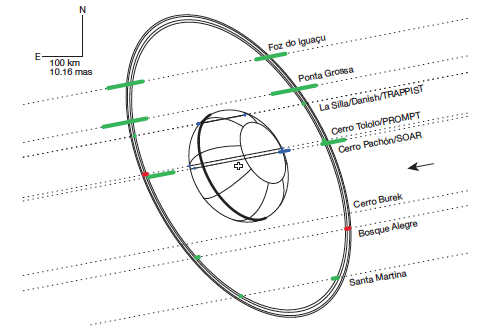Occultation
Occultation is a powerful technique to derive the size and cross section of a small body in a direct way.
Stellar occultations provide another way to determine sizes, shapes and albedos of planets, satellites (including the Moon) and also minor bodies (Elliot 1979; Elliot & Young 1992). This is by far the most accurate and powerful technique, as it provides diameters with kilometric accuracy, what is more, it allows to determine the shape of the body, and can even reveal the presence of atmospheres with pressures down to a nano-bar (nbar) level. The basis of the technique is to predict when the particular body will pass in front of a certain star, and during the occultation one measures the flux of the star from a few locations within the predicted shadow. In that way the material around the body (rings or satellites), the atmosphere, and the shape of the body can be studied in detail. This technique is well developed for planets and satellites, and also for large main-belt asteroids, but it is only an emerging field for TNOs. Predicting and observing stellar occultations by TNOs is extremely difficult and challenging because the angular diameters of TNOs are very small and neither the stellar catalogues nor the TNOs orbits have the required accuracy to make reliable predictions well in advance.
A multi-chord stellar occultation by Trans-neptunian Objects allows us to determine the projected shape and orientation of the body in the plane of sky at the moment of the occultation. However, this information is insufficient to determine the true 3D shape of the body and its spin axis orientation in space. Combining the occultation-derived information with rotational lightcurves one can distinguish whether the 3D shape of the body is an oblate spheroid or a Jacobi ellipsoid (usually the very low lightcurve amplitude imply MacLaurin oblate shapes, whereas amplitudes larger than 0.15 mag imply Jacobi shapes). But the spin axis orientation is still not well constrained (unless many high-precision rotational lightcurves spanning many years exist). Thermal observations modelling are a great help in this regard. This kind of observations allows us to put tighter constraints on the spin axis orientation in space by modelling the thermal output of the object. The basic parameters for thermal models are the size, shape, albedo, rotation rate, spin axis orientation, and surface properties such as e.g. thermal inertia. Given that the occultation timings provides a very accurate size, shape and albedo, and if the rotation period is also known from the rotational lightcurves, the remaining parameters can be tightly constrained. Thus, the combination of occultation timings, optical lightcurves and thermal measurements can allow us to determine a full 3D shape and spin axis orientation in space. Once this all is known, bulk densities can be determined accurately using the Chandrasekhar figures of equilibrium formalism.
We can use the case of one TNO as an example of how thermal observations can improve our knowledge. On November 15th 2014, a stellar occultation by the TNO with provisional designation 2007 UK126 was observed. The obtained chords give an ellipse with axes of 679.2 ± 9.8 km and 622.0 ± 5.4 km (Schindler et al., submitted). We can illustrate how the combination of this result with thermal observations by Herschel can improve our knowledge. Assuming an equatorial orientation and taking a rotation period determination of 11.05 h, a radiometric size solution that matches the occultation measurements could be easily derived. The best (and physically most-likely) solution is found for a MacLaurin ellipsoid with low surface roughness combined with a thermal inertia value between Γ = 2 - 3 Jm-2s-0.5K-1. This value also resembles roughly the thermal inertia that is expected at these large heliocentric distances.
Another example of the power of this technique is brought by work of Ortiz et al. (2012), who found a radius of the TNO named Makemake to be 1430 ± 9 km, and a hint of an atmosphere. Recently, the existence of rings around two minor bodies was discovered: around (10199) Chariklo by Braga-Ribas et al. (2014) and around (2060) Chiron by Ortiz et al (2015).


Left panel: dense telescopic observations (chords) of the stellar occultation by (9) Metis revealing the shape of the occulting body, with the superimposed independent shape model based exclusively on lightcurves (Bartczak et al. 2014). Right panel: observations of the stellar occultation by (10199) Chariklo, where the presence of rings around a minor body was first discovered (Braga-Ribas et al., 2014).
